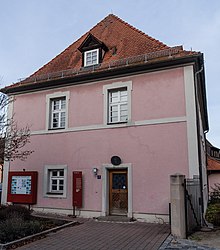Zeidelgericht
The Zeidelgericht is a historic building in the market town of Feucht in the Middle Franconian district of Nürnberger Land in Bavaria .
description
The restored building in Feucht on Obere Zeidlerweg 2 (formerly Mittlerer Zeidelweg) is a former courthouse . The property is directly adjacent to the Zeidlerschloss . The so-called Zeidelgericht has been designated as an architectural monument by the Bavarian State Office for the Preservation of Monuments (D-5-74-123-27). The building is located on the historic Drei-Schlösser-Rundweg . An information board was set up in front of the entrance.
history
The Zeidlers play an important role in the history of the market town of Feucht . The word Zeidel means honey and zeideln means to cut the honeycombs out of the stick. The Zeidler were people who kept bees in the forest .
The seat of the court was in Feucht from the beginning. The place in the Reichswald was considered the center of forest beekeeping and honey production. At that time, the Zeidelgericht was an institution of imperial justice , the history of which goes back to 1296. In 1296, the appointment of Zeidelmeister Hildebrand by the imperial district judge Rüdiger von Brant was documented in a document. It was referred to the Zeidelgericht that only the Zeidelgericht has a right to speak about the Zeidlers. In another document from 1350, the so-called Zeidler privilege, Emperor Charles IV confirmed the Zeidlers their rights and obligations towards the Emperor and the Empire.
The Zeidelgüter managed by the Zeidler were divided into three types. So-called mother goods, daughter goods and single-layer goods. If a Zeidelgut could demand taxes from another, the daughter estate, it was a mother estate. A single-layer good was an independent Zeidelgut. In the early 16th century there were 50 Zeidelgüter in the thirteen villages of the Reichswald. Ten of these were mother estates, 22 daughter estates and 18 single-layer Zeidelgüter. However, due to changes in ownership, the number fluctuated in the following years.
In the course of the following centuries, the Zeidelgericht, which initially only served to settle disputes among the Zeidlers, developed into a local court for the entire population. The court was originally chaired by the Zeidelmeister elected by the owners of the Zeidelgüter. Under the influence of the imperial city of Nuremberg , it was subsequently a so-called instructor who was assisted by twelve lay judges from the circle of Zeidler. Until 1669 the Zeidelgericht met regularly on January 6th, May 1st and September 29th of each year.
In the period that followed, it was increasingly in competition with the Nuremberg farmers' court and the Lorenzi forestry court in the imperial city. The importance of the Zeidelgericht dwindled. The reference to the original Zeidel creature had already been lost due to the decline of forest beekeeping in the middle of the 16th century. With the discovery of America and the import of sugar cane and the cultivation of sugar beet , honey slowly became meaningless as a sweetener. The Zeidelgericht was finally dissolved in 1796. The last Margrave of Ansbach-Bayreuth ceded his land to the Kingdom of Prussia in 1792 . The old dispute between the Free Imperial City of Nuremberg and the margrave over his rights to the Nuremberg land through annexation had been settled. In 1806 the province of Ansbach became Bavarian and the Zeidlerschloss became the new seat of the royal Bavarian judicial office in Burgthann. Feucht's history as the seat of the court ended in 1808 with the establishment of the royal regional court in Altdorf .
Todays use
After a long period of use as a residential building, the former Zeidelgericht has belonged to Markt Feucht since 1980. After the renovation of the building with the original sandstone facade, the community made the rooms available to the communal internet cafe , the Feucht music association and a local music school.
See also
Individual evidence
- ↑ Bavarian State Office for Monument Preservation, Feucht Monument List (accessed on December 2, 2018)
- ↑ www.feucht.de, Zeidelgericht (accessed on December 2, 2018)
- ↑ www.feucht.de, Drei-Schlösser-Rundweg (accessed on December 2, 2018)
- ^ A foray through history, Feucht, Martin Schieber, ISBN 978-3-930699-72-8 . Pp. 44-47
- ↑ Musikbund Feucht .eV (accessed on December 2, 2018)
Web links
Coordinates: 49 ° 22 '35.36 " N , 11 ° 12' 47.99" O



